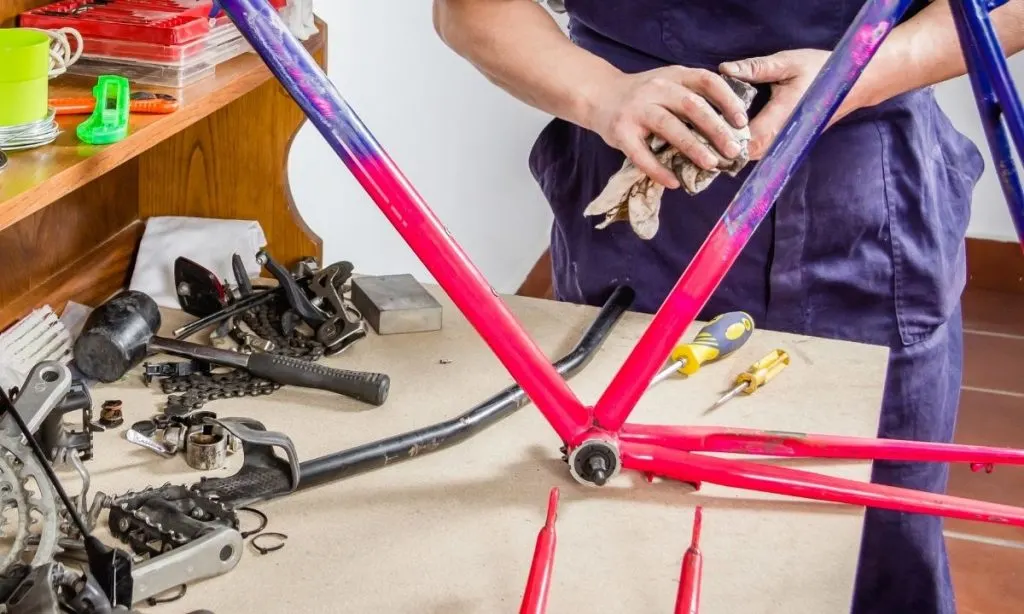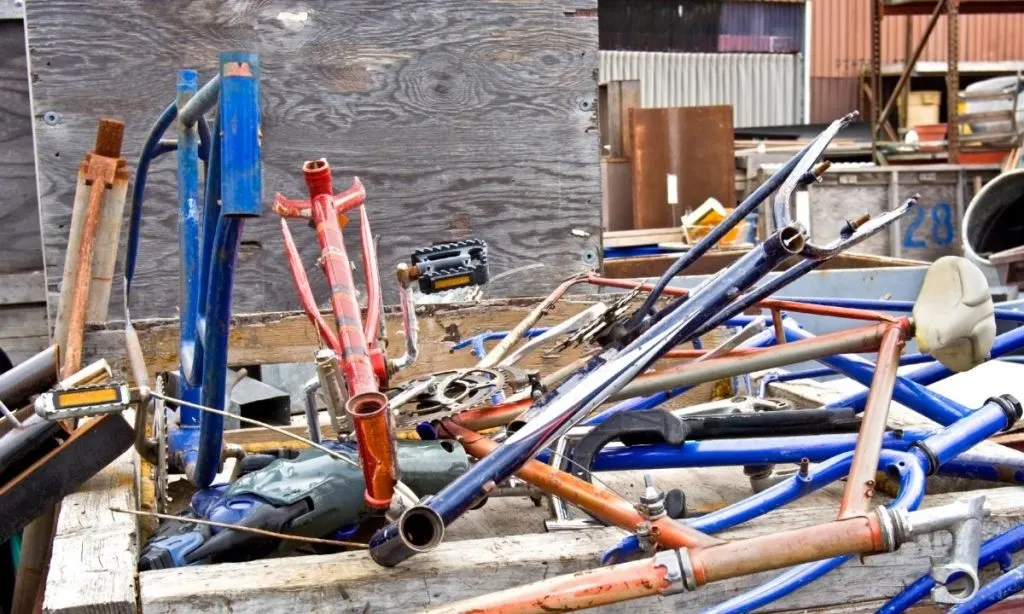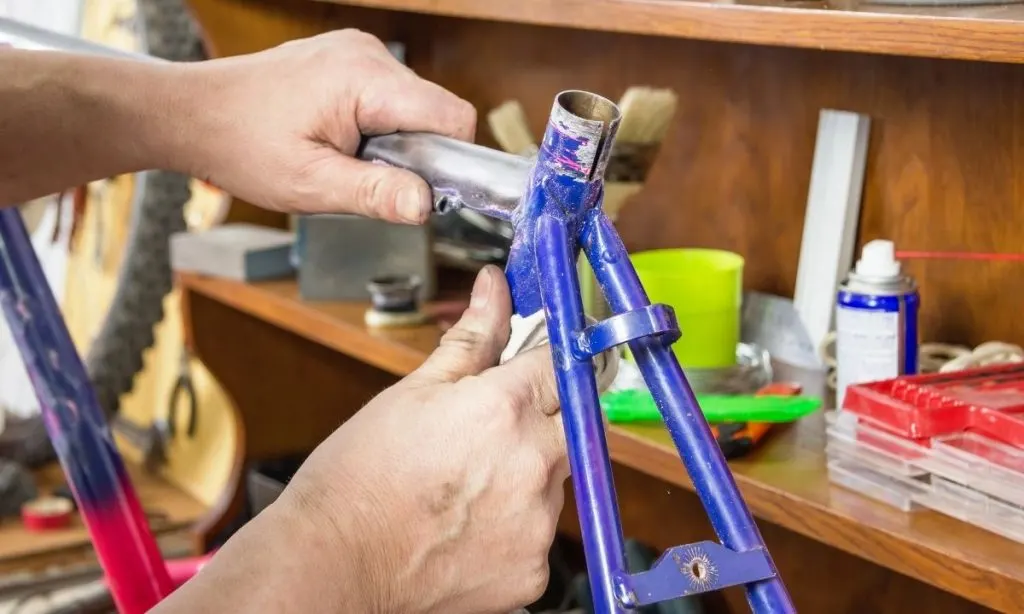
The frame of a bike is its heart and soul. Everything else fits on or around it. Occasionally due to crashes or careless transporting, bike frames can get damaged, scratched, and even cracked, and when this happens, the question is whether it’s worth fixing.
All three bike frame materials: carbon fiber, aluminum, and steel, can be straightened and fixed. So it’s entirely possible to straighten any bike frame. However, it is crucial to ensure it is done correctly so that your comfort and safety are not compromised.
There are certainly situations where you shouldn’t fix your bike frame too. Let’s take a more in-depth look at how and why bike frames bend or crack, and when they can and can’t be straightened or fixed.
How Does A Bike Frame Bend?
The most common occurrence is due to impact, and heavy impact at that. Bike frames are solid, designed to carry the rider’s weight and absorb any impact force while riding.
But a high-speed crash can cause the frame to bend or even break, and whether on the road or the trail, the results can be catastrophic for both the rider and the bike.
The frame can bend under pressure or stress caused by impact on landing too (e.g. downhill racing and jumping). And the effect doesn’t have to be that significant to result in a bend. Combining the bike weight, rider weight, and inertia could create considerable stress on the frame.
While bike frames, in general, are designed to withstand impact, there are times when the force involved is too high.
The Risk of Bike Frame Failure
Carbon and aluminium frames have the potential to get to ‘catastrophic failure’, which means a sudden, unexpected and total failure of the bike frame. This is not something you want to risk when riding.
Steel would hold up for a bit longer due to its higher natural strength, but if you’ve had a crash or suspect an issue with the frame, the next step is to get it assessed.
The risk of the more lightweight materials failing without warning is real, and the consequence of suddenly crashing due to frame failure could result in severe injury or worse.
A frame will encounter minute movement under everyday riding stress, but the frame integrity allows it to remain solid and intact.
REMEMBER: Any bend or crack in the frame will question the frame integrity, and continued use could be hazardous indeed.
Like a small crack in a dam wall, the pressure of the water behind it will cause that crack to widen and grow, eventually spilling more and more water as the whole wall weakens. Unless that fault is recognized, analyzed, and repaired correctly; finally, the dam will break.
Your bike frame is no different.
In essence, even if the bike feels ok and there is no immediate variation in performance or handling, the pressure and stress of continued use will eventually cause the frame to fail; it’s simply a question of time and not something worth risking life and limb over.
Following a professional assessment of a bent or cracked frame, you can determine whether the repair cost would be worth doing.
Suppose the frame is too severely damaged and can’t be repaired, then it’s time to go shopping for a new one. If it had any sentimental value attached, then you can put it up on your wall in the garage or bar.
The good news is that, for the most part, bent and cracked frames can now be repaired at a fraction of the cost it would be to replace them. While components like forks, handlebars, and dropouts are replaced if damaged, your bike frame has a great chance of being repaired!
REMEMBER: If you find yourself with a bent or cracked frame, whether carbon, aluminum, or steel, get a professional assessment to determine the extent of the damage before deciding if repair is worth it or not.
Let’s take a closer look into which types of bike frames (carbon fiber, aluminium or steel), can be repaired, and when it is or isn’t worth it for each type…
Can you Repair/Straighten Carbon Bike Frames?
Carbon fiber is the lightest of the three frame materials, with aluminum second and steel being the heaviest. Most mid to high-end bikes are made from carbon fiber, and it makes sense then that most competitive and professional riders use carbon frames to give them an advantage in competition.

With the popularity of these lightweight frames, the technology has vastly improved to the point where it’s easier to repair carbon fiber than steel!
Using x-rays and other scanning systems, a suitably qualified technician can find and restore the frame to the same strength as it was before. They can’t make it stronger as this would then place undue pressure on other frame areas.
This is not a patch job; this is a complicated technical process that repairs and restores the frame’s original integrity and cosmetics.
Not only that, but a skilled technician will be able to advise whether the frame could be restored to its pre-damage condition. This article I wrote on how often you need to get your bike serviced should help you make it a habit to get your bike checked by a professional regularly.
This means that BEFORE you have to spend money, you will know whether your repaired frame will be safe to ride once the job is done, which mitigates the risk of spending money and being uncertain about the outcome.
Once the initial assessment is done, the repair process will begin, and one of the great things about this is that any other cracks, dents, or chips will also be repaired. Then the frame will be stress-tested, painted and your bike will come back good as new!
The good news is that you won’t have to worry about the integrity of the repaired frame as it will have the same strength as the original!
NOTE: Not all frames can be fixed. Severely damaged ones will be assessed, and you’ll be advised as to the extent of the damage and whether your frame can be salvaged or not. But in most cases, a carbon fiber frame can be resurrected for another life of cycling.
Is It Worth Fixing a Carbon Fiber Bike Frame?
The easy answer is yes. Since carbon fiber frames often cost thousands of dollars, shelling out a few hundred to have your frame fixed far outmatches the cost of buying a new one.
The only drawback is that you could wait a few days to a few weeks to get your bike back, depending on the time of year. The actual repair time collectively is only about 2-3 hours.
The other benefit is that the frame geometry doesn’t change, so you will feel as good riding on the repaired frame as you did on the original one.
Can you Repair/Straighten Aluminum Bike Frames?
With aluminum, a similar set of rules apply. The aluminum compounds of 6000 and 7000 are super strong and light, but in most cases, there is often no comeback or repair once cracked or bent.
This is because aluminum will crack if bent, and that crack will grow over time until it fails, which could also be a disaster for the rider. The issue with aluminum is that adding heat to the frame affects its properties of strength, which could compromise the frame and the rider’s safety.
NOTE: If the aluminum frame has indeed been compromised, other areas of the structure may also be broken or cracked, and even if those are tiny, they will grow larger with time and fail.
Furthermore, you can’t simply weld the frame. The entire structure would need to be annealed and re-tempered, and the cost of this would be prohibitive. However, a skilled artisan with knowledge of both aluminum and bike frames could possibly repair a frame.
This would depend on the severity of the bend and the ability of the craftsman. Sometimes you can get lucky with both the break location and the aluminum work. So before you chuck the frame, it may be worthwhile to get a few second opinions.
Again, the technology comes into play to assess the damage and whether or not it’s worth it to repair.
Out of the three bike frame materials, aluminum has the lowest chance of successful repair.
Can you Repair/Straighten Steel Bike Frames?
Steel frames are the heaviest of all three and were the original materials or bike frame construction before aluminum. Since steel frames are forged and welded, they can be repaired using the same methods.
Steel can be heated and welded with little or no risk to structural integrity, so recovery is possible. A reputable bike frame builder with the right tools and ability could repair the frame or straighten it.
Much of the decision whether to straighten a bent frame will depend on:
- where the structure is bent
- how badly it’s bent
- the cost of repair
Can You Straighten Or Fix Your Bike Frame At Home?
Yes, you can. The question is, would you want to? With Carbon Fiber, you can buy home repair kits, but you risk doing more damage than repair, unless you really have the skill set, tools, and know-how.
REMEMBER: Simply slapping some carbon fiber over the crack will not restore the frame strength as it would if professionally done, and the risk of failure becomes real. Plus, you would not be able to do the cosmetic work.
The same would apply to aluminum. Trying to bend or straighten aluminum would only result in more damage unless you really have the skills to work with aluminum and understand the complexity of bike frame repair.

For a steel frame, you could conceivably straighten the back forks by stripping the bike down and using very gentle pressure to straighten a bend, but again, the risk of too much pressure and more damage is high.
All in all, it’s not something that I would recommend due to the consequences of not getting it right. But the ultimate question is, when should you repair, and when should you replace?
Repairing a Bike Frame vs Replacing it
Even if the frame can be repaired regardless of the material, is it worth doing? There are a few factors to consider…
#1: The Price Of Repair VS Replacement
In most cases, the repair cost will be significantly cheaper than replacing either the frame or the whole bike. Even if you can use the other components like the front forks, handlebars, etc., the cost of a new frame or bike, especially carbon fiber, will run into thousands of dollars.
For between $100 (for minor nicks and chips) up to about $400, you can walk away with your bike as good as new. The only drawback is the time it may take to repair your frame, as you may be off the road or trail for a few weeks at worst.
#2: Bike Geometry And Comfort
If you opt for a new bike, you’ll need to find one with similar geometry to suit your body and riding style. This means you’ll also need to do the setup again, adding more cost. While you can ride off on your new bike in a day or so, there will be time needed to adjust.
With the repair option, you’ll get back on, and it will feel the same as before! No setup, no extra cost, and no period of adjustment. Plus, the controls and reaction of the bike won’t have changed either.
#3: Peace Of Mind
Many argue that riding a bike whose frame has been repaired leaves that little thought about failure at the back of the mind. There is always that lingering question as to whether this frame will indeed stand up to the rigors of riding full pace.
Well, you actually don’t have to worry at all about this. The professional assessment would include whether the frame would regain its original strength and durability if the repair is done.
The repair technician will have done a proper inspection of the extent of the damage and its location to determine whether fixing the frame will be plausible or not.
TIP: It is critical to have your bent or damaged frame assessed by a professional who will advise you on the best course of action to ensure that you are safe on your bike after the frame is straightened or repaired.
#4: Sentimental Value
Losing a beloved bike that you have spent many hours on and collected a lifetime of memories riding is never an easy thing to accept. Repairing your favorite bike and having it around for another ten or twenty years is often more desirable than getting a new one!
Perhaps the thought of having to retire the frame and leave it up on a wall somewhere doesn’t really work for you. And here, you can have the frame straightened or fixed and carry on the love affair for another two decades!
Crossing The Finish Line
The answer to whether you can successfully straighten a bent bike frame or repair a cracked one and whether it’s worth it is most definitely yes, and this bodes well for all manner of cyclists and bikes, whether steel, aluminum, or carbon fiber.
The most critical point here is that if you have a bent or cracked frame, stop using it immediately, get it professionally assessed, and make an informed decision.
Whatever the outcome, you will have many long years of safe riding ahead of you.
